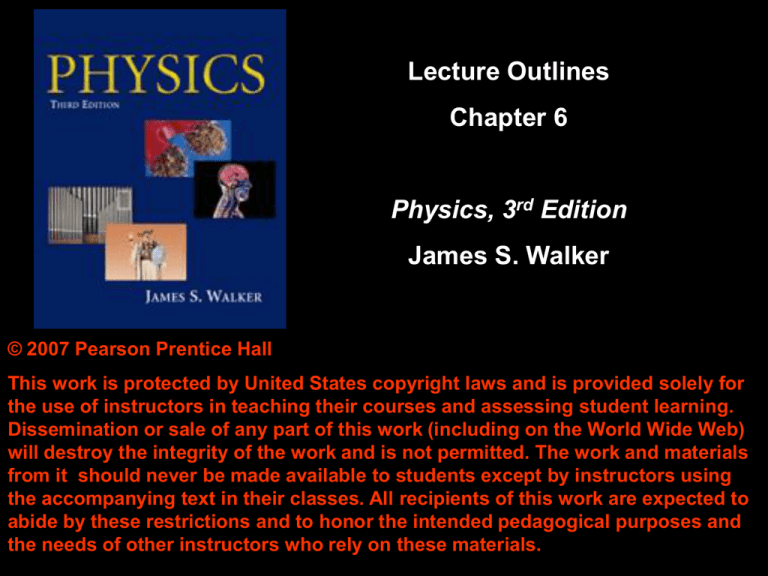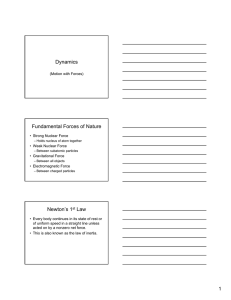
Lecture Outlines
Chapter 6
Physics, 3rd Edition
James S. Walker
© 2007 Pearson Prentice Hall
This work is protected by United States copyright laws and is provided solely for
the use of instructors in teaching their courses and assessing student learning.
Dissemination or sale of any part of this work (including on the World Wide Web)
will destroy the integrity of the work and is not permitted. The work and materials
from it should never be made available to students except by instructors using
the accompanying text in their classes. All recipients of this work are expected to
abide by these restrictions and to honor the intended pedagogical purposes and
the needs of other instructors who rely on these materials.
Chapter 6
Applications of Newton’s
Laws
Units of Chapter 6
• Frictional Forces
• Strings and Springs
• Translational Equilibrium
• Connected Objects
• Circular Motion
6-1 Frictional Forces
Friction has its basis in surfaces that are not
completely smooth:
6-1 Frictional Forces
Kinetic friction: the friction experienced by
surfaces sliding against one another
The static frictional force depends on the normal
force:
(6-1)
The constant
kinetic friction.
is called the coefficient of
6-1 Frictional Forces
6-1 Frictional Forces
The kinetic frictional force is also independent
of the relative speed of the surfaces, and of their
area of contact.
6-1 Frictional Forces
The static frictional force keeps an object from
starting to move when a force is applied. The
static frictional force has a maximum value, but
may take on any value from zero to the maximum,
depending on what
is needed to keep
the sum of forces
zero.
6-1 Frictional Forces
(6-2)
where
(6-3)
The static frictional force is also independent
of the area of contact and the relative speed of
the surfaces.
6-2 Strings and Springs
When you pull on a string or rope, it becomes
taut. We say that there is tension in the string.
6-2 Strings and Springs
The tension in a real rope will vary along its
length, due to the weight of the rope.
Here, we will assume that
all ropes, strings, wires,
etc. are massless unless
otherwise stated.
6-2 Strings and Springs
An ideal pulley is one that simply changes the
direction of the tension:
6-2 Strings and Springs
Hooke’s law for springs states that the
force increases with the amount the
spring is stretched or compressed:
The constant k is called the spring
constant.
6-3 Translational Equilibrium
When an object is in translational equilibrium,
the net force on it is zero:
(6-5)
This allows the calculation of unknown forces.
6-3 Translational Equilibrium
6-4 Connected Objects
When forces are exerted on connected objects,
their accelerations are the same.
If there are two objects connected by a string,
and we know the force and the masses, we can
find the acceleration and the tension:
6-4 Connected Objects
We treat each box as a separate system:
6-4 Connected Objects
If there is a pulley, it is easiest to have the
coordinate system follow the string:
6-5 Circular Motion
An object moving in a circle must have a force
acting on it; otherwise it would move in a straight
line.
The direction of the
force is towards the
center of the circle.
6-5 Circular Motion
Some algebra gives us the magnitude of the
acceleration, and therefore the force, required
to keep an object of mass m moving in a circle
of radius r.
The magnitude of the force is given by:
(6-15)
6-5 Circular Motion
This force may be provided by the tension in a
string, the normal force, or friction, among
others.
6-5 Circular Motion
6-5 Circular Motion
An object may be changing its speed as it
moves in a circle; in that case, there is a
tangential acceleration as well:
Summary of Chapter 6
• Friction is due to microscopic roughness.
• Kinetic friction:
• Static friction:
• Tension: the force transmitted through a
string.
• Force exerted by an ideal spring:
Summary of Chapter 6
• An object is in translational equilibrium if the
net force acting on it is zero.
• Connected objects have the same acceleration.
• The force required to move an object of mass m
in a circle of radius r is:






